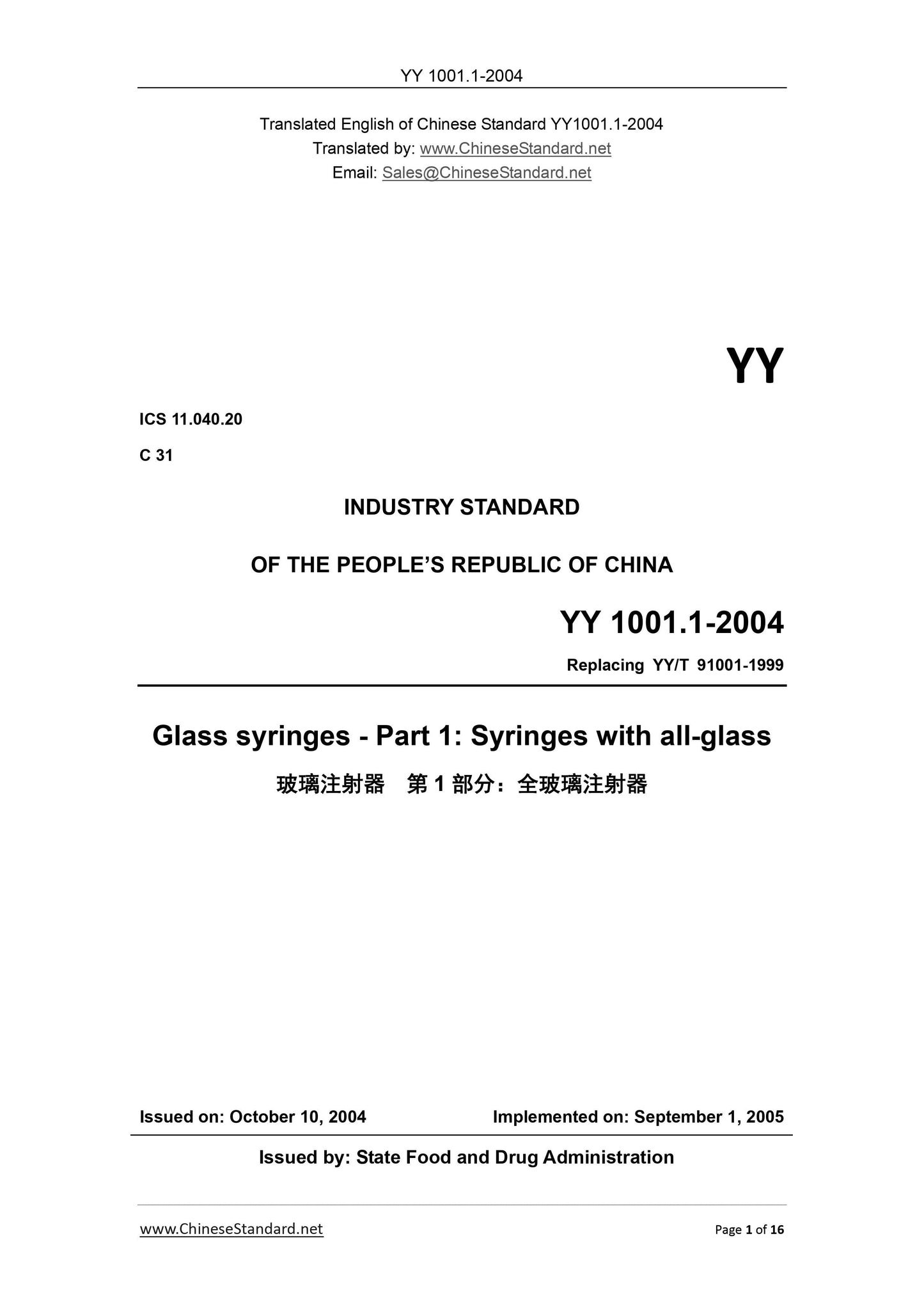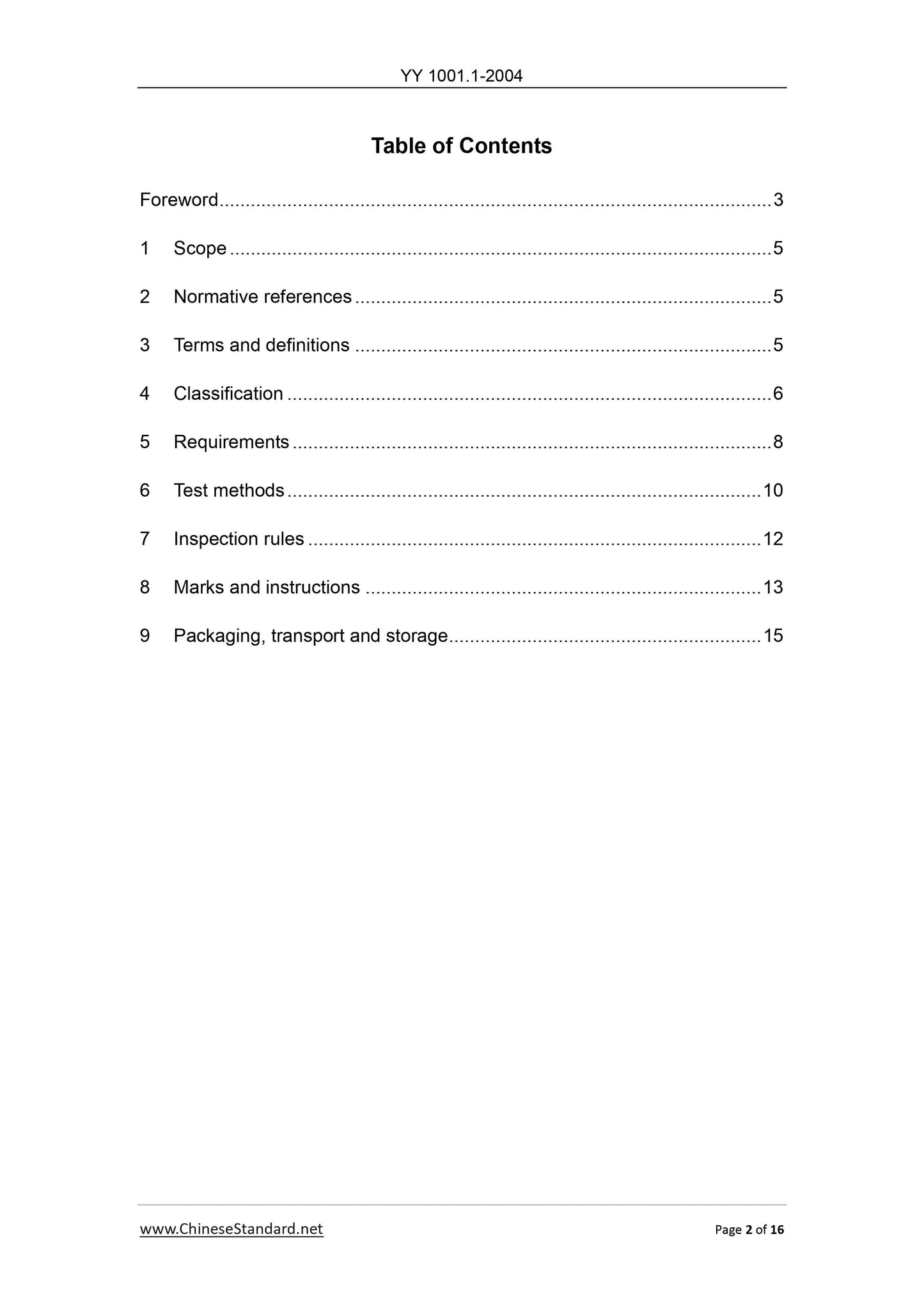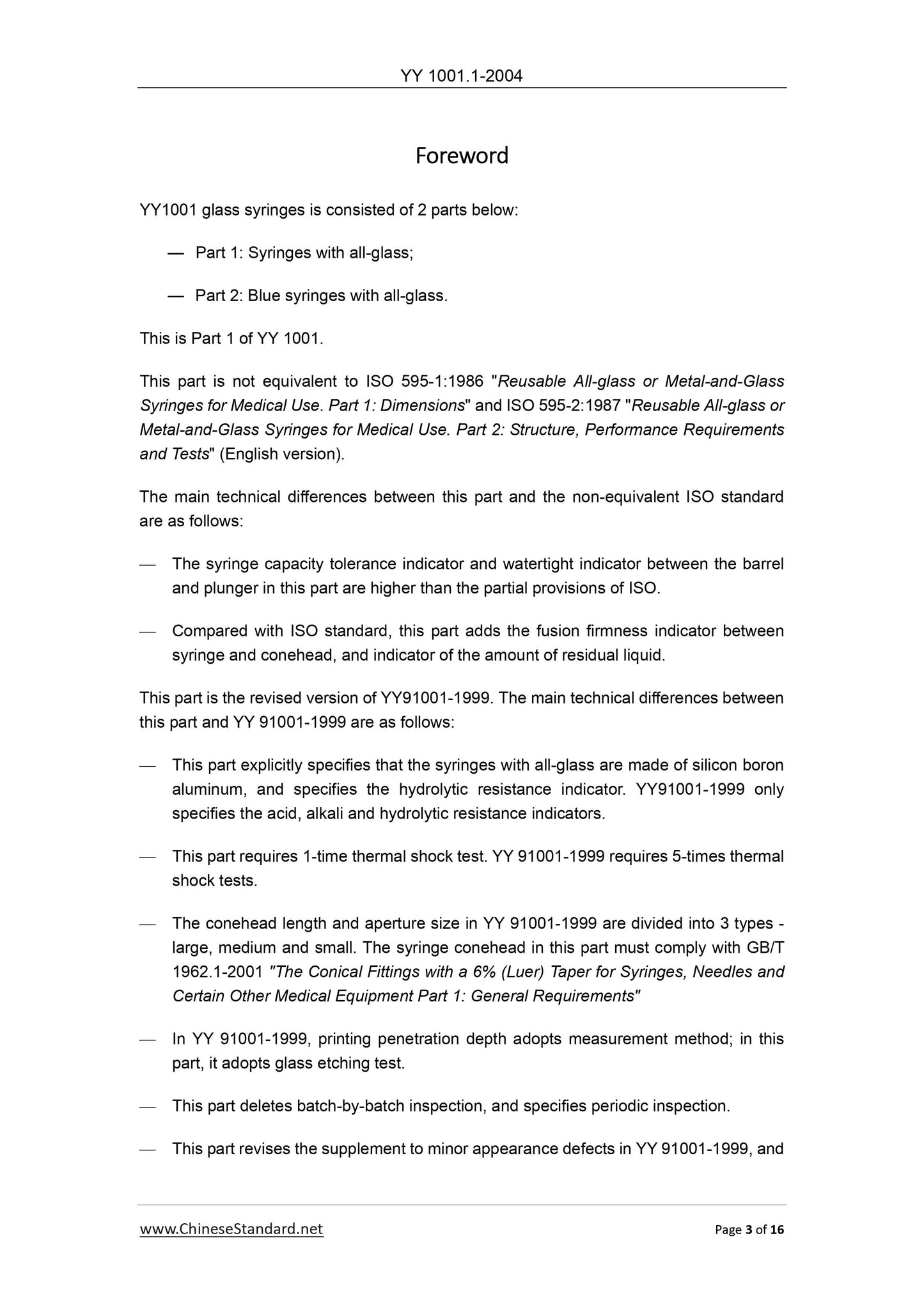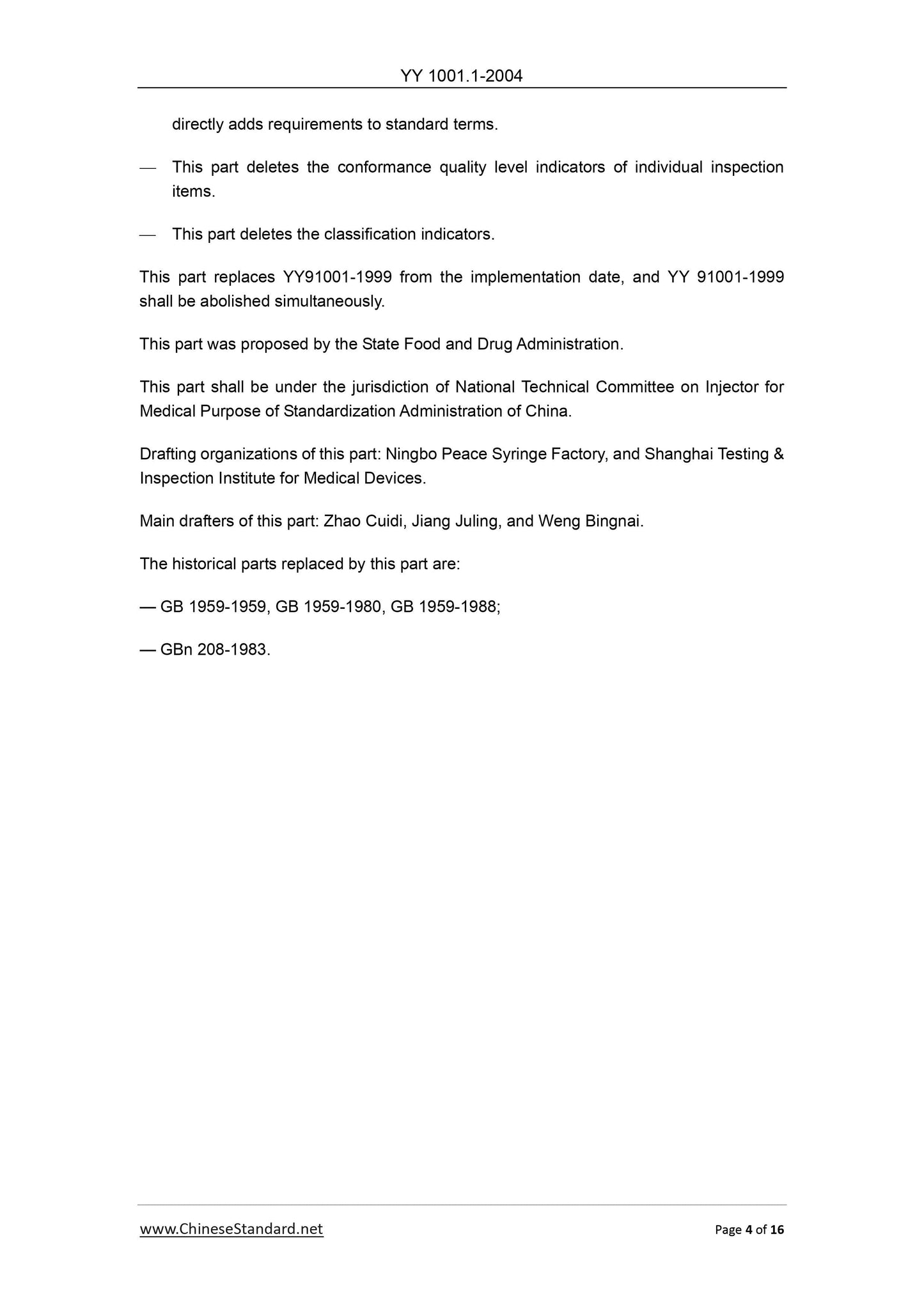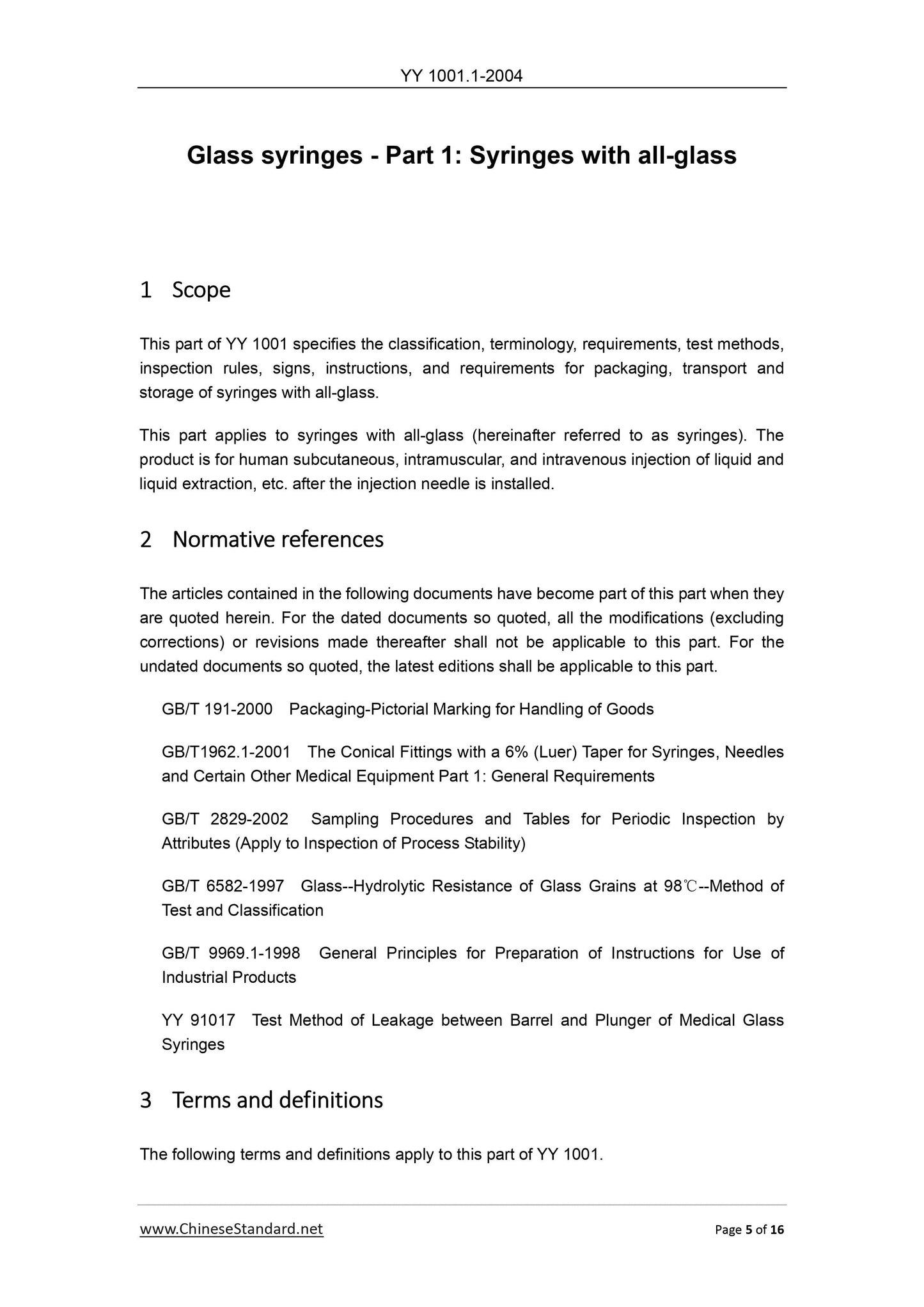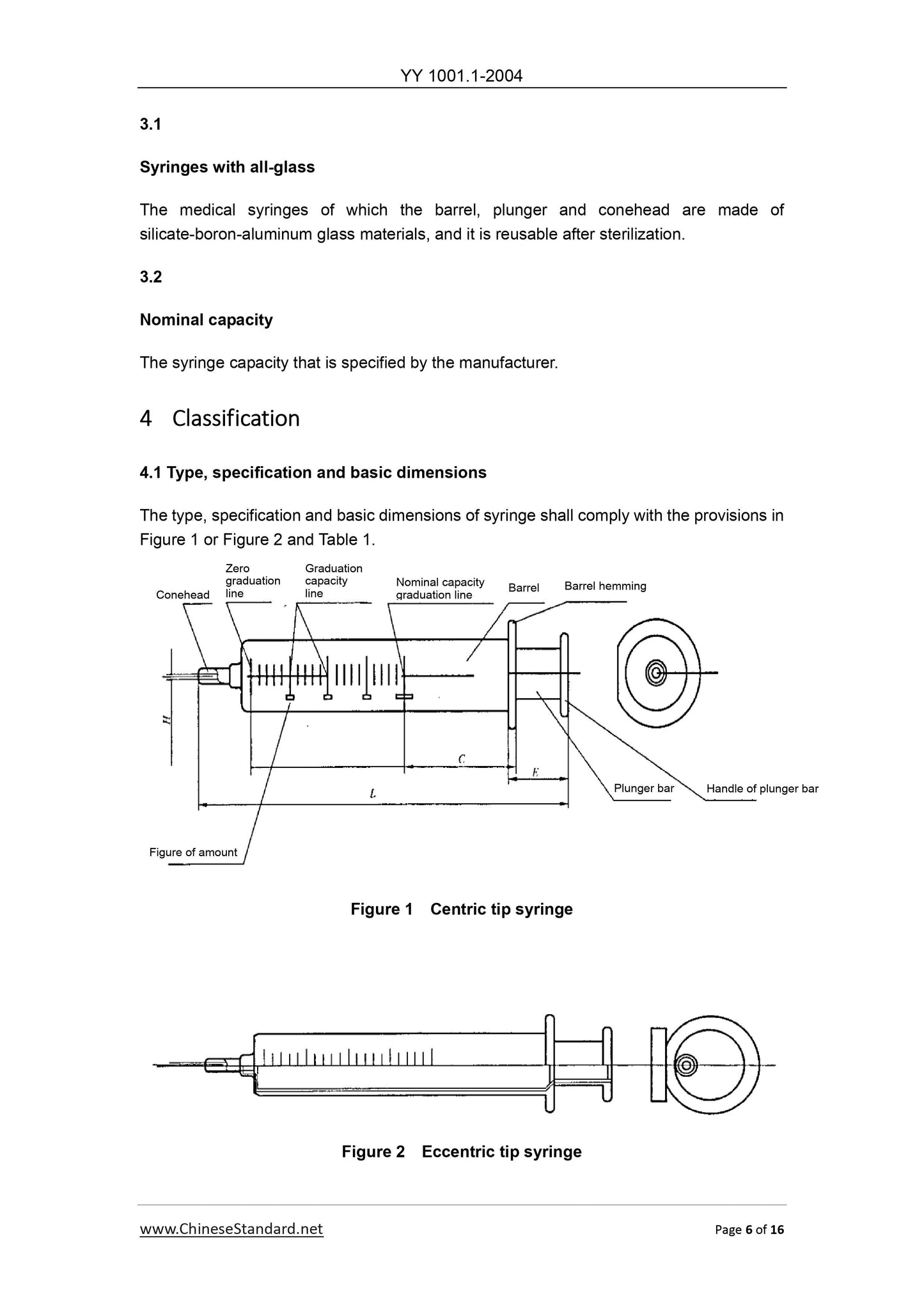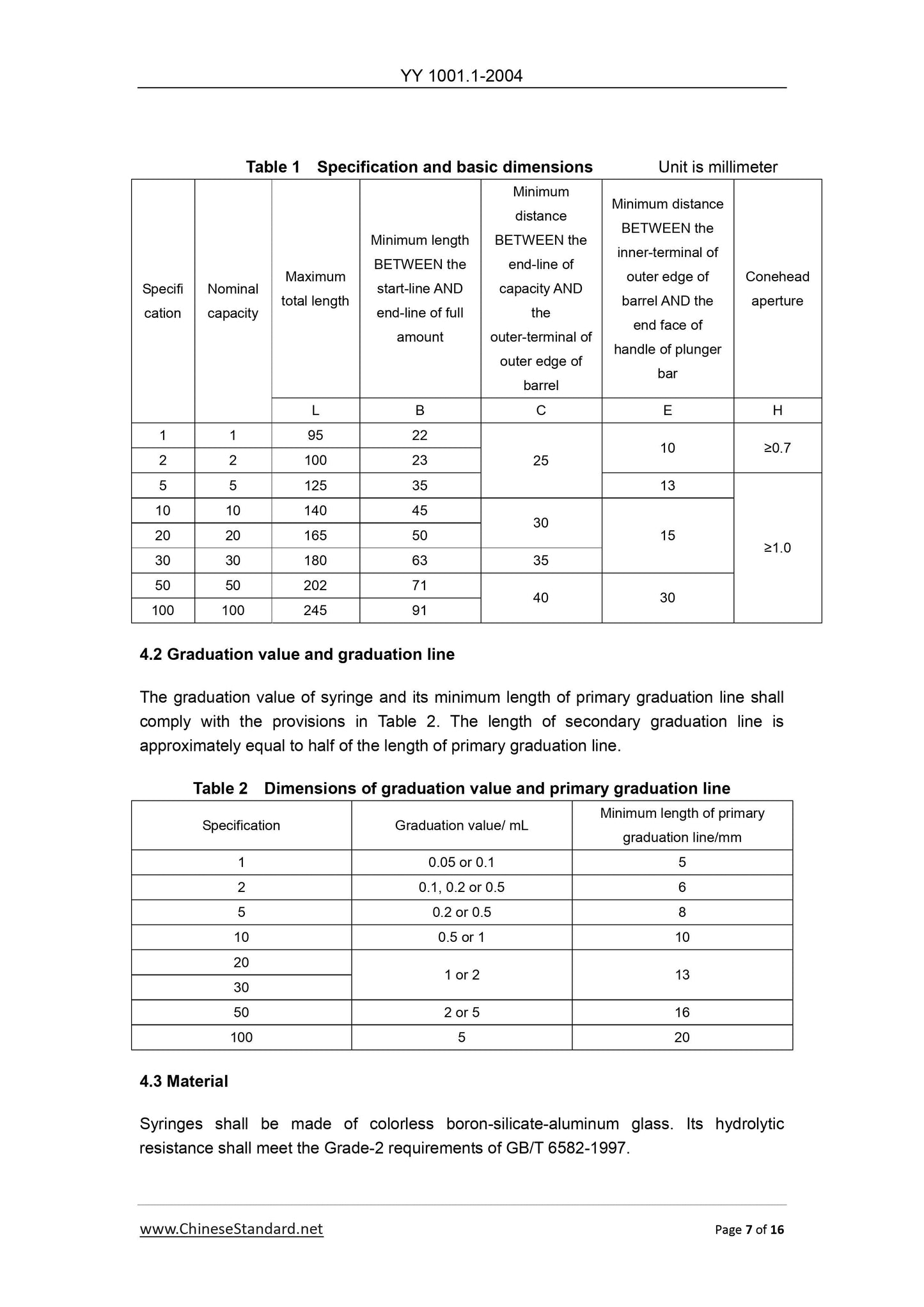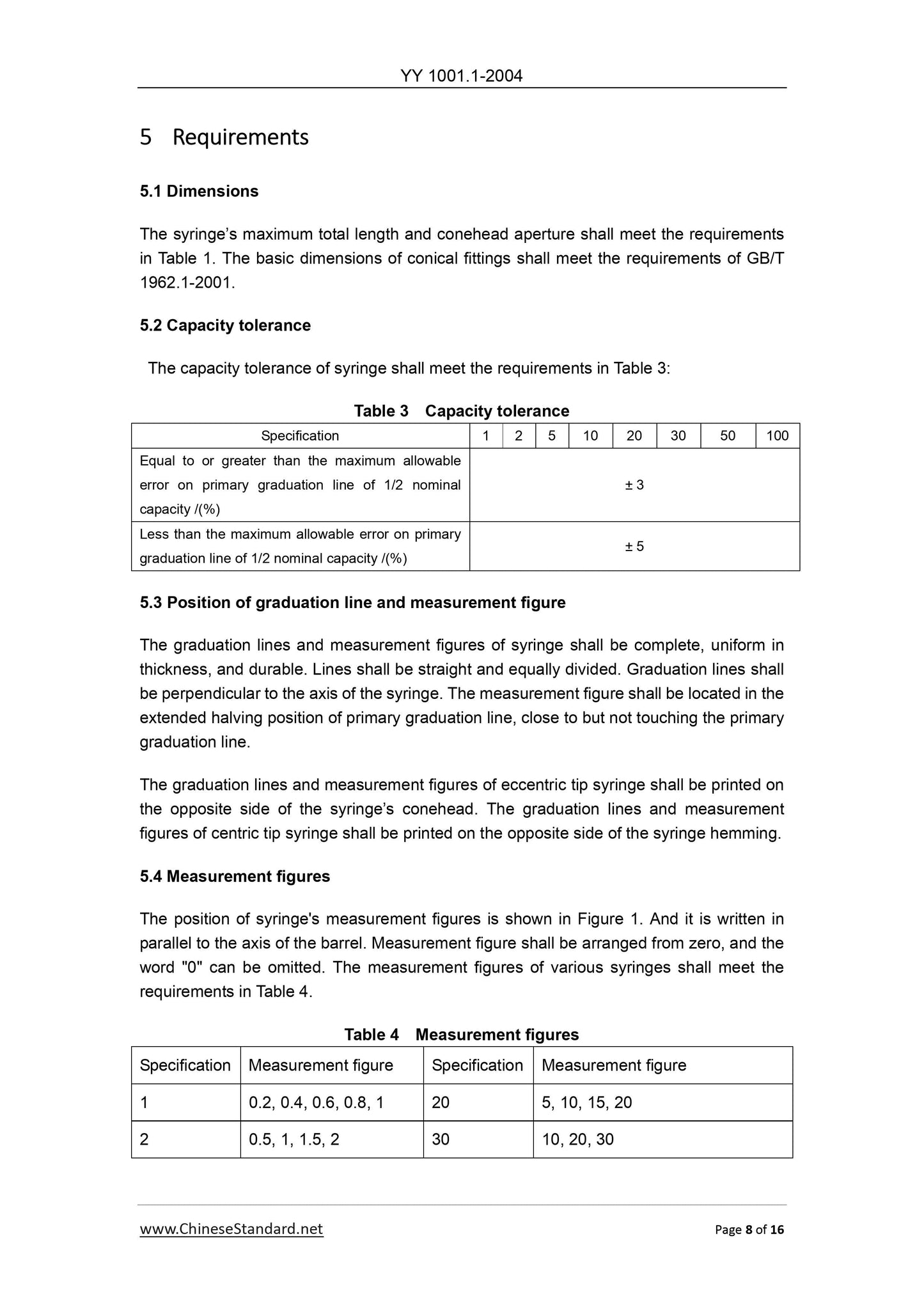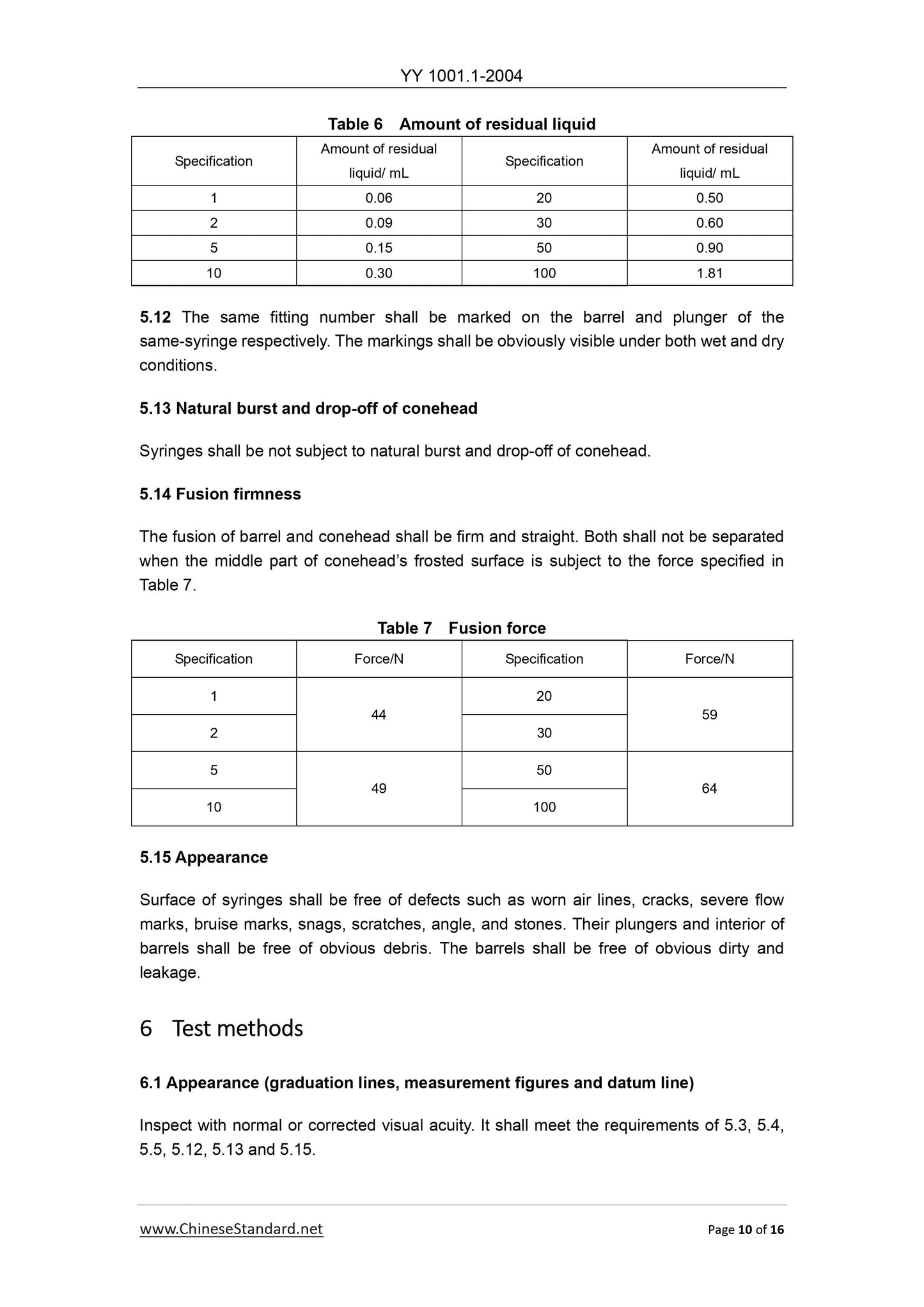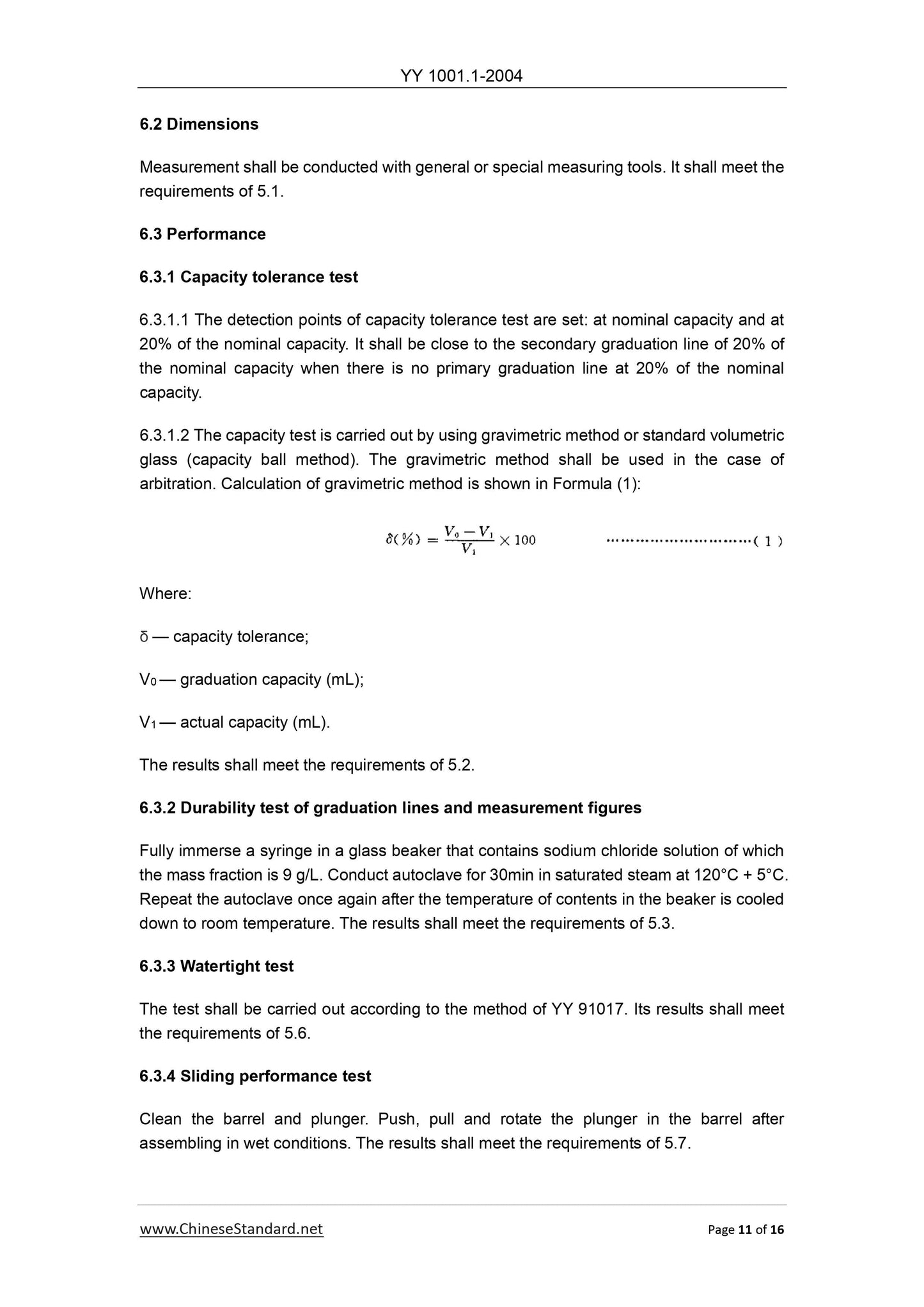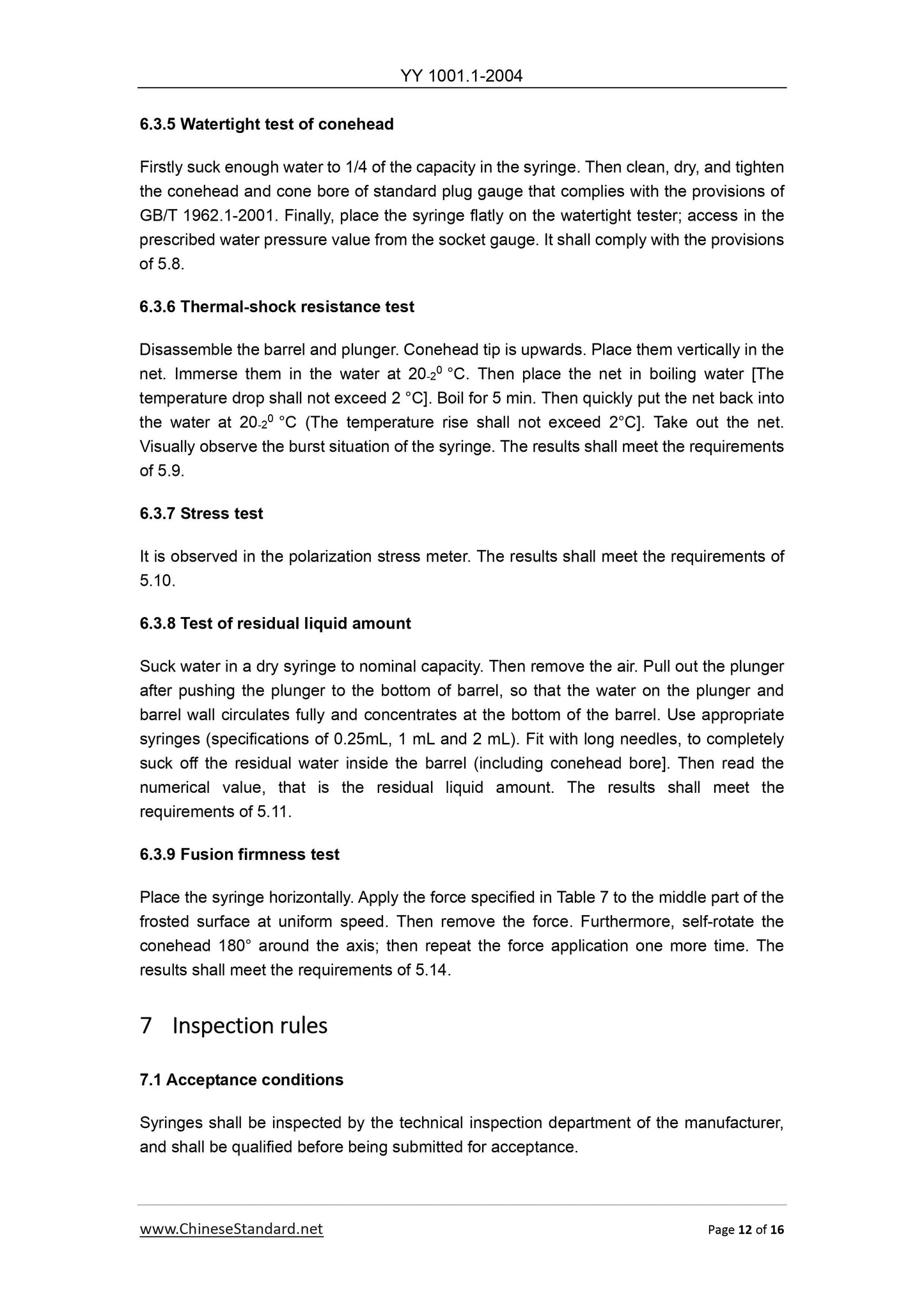1
/
su
12
PayPal, credit cards. Download editable-PDF & invoice in 1 second!
YY 1001.1-2004 English PDF (YY1001.1-2004)
YY 1001.1-2004 English PDF (YY1001.1-2004)
Prezzo di listino
$120.00 USD
Prezzo di listino
Prezzo scontato
$120.00 USD
Prezzo unitario
/
per
Spese di spedizione calcolate al check-out.
Impossibile caricare la disponibilità di ritiro
Delivery: 3 seconds. Download true-PDF + Invoice.
Get QUOTATION in 1-minute: Click YY 1001.1-2004
Historical versions: YY 1001.1-2004
Preview True-PDF (Reload/Scroll if blank)
YY 1001.1-2004: Glass syringes - Part 1: Syringes with all-glass
YY 1001.1-2004
YY
ICS 11.040.20
C 31
INDUSTRY STANDARD
OF THE PEOPLE’S REPUBLIC OF CHINA
Replacing YY/T 91001-1999
Glass syringes - Part 1. Syringes with all-glass
ISSUED ON. OCTOBER 10, 2004
IMPLEMENTED ON. SEPTEMBER 1, 2005
Issued by. State Food and Drug Administration
Table of Contents
Foreword ... 3
1 Scope ... 5
2 Normative references ... 5
3 Terms and definitions ... 5
4 Classification ... 6
5 Requirements ... 8
6 Test methods ... 10
7 Inspection rules ... 12
8 Marks and instructions ... 13
9 Packaging, transport and storage ... 15
Foreword
YY1001 glass syringes is consisted of 2 parts below.
— Part 1. Syringes with all-glass;
— Part 2. Blue syringes with all-glass.
This is Part 1 of YY 1001.
This part is not equivalent to ISO 595-1.1986 "Reusable All-glass or Metal-and-Glass
Syringes for Medical Use. Part 1. Dimensions" and ISO 595-2.1987 "Reusable All-glass or
Metal-and-Glass Syringes for Medical Use. Part 2. Structure, Performance Requirements
and Tests" (English version).
The main technical differences between this part and the non-equivalent ISO standard
are as follows.
— The syringe capacity tolerance indicator and watertight indicator between the barrel
and plunger in this part are higher than the partial provisions of ISO.
— Compared with ISO standard, this part adds the fusion firmness indicator between
syringe and conehead, and indicator of the amount of residual liquid.
This part is the revised version of YY91001-1999. The main technical differences between
this part and YY 91001-1999 are as follows.
— This part explicitly specifies that the syringes with all-glass are made of silicon boron
aluminum, and specifies the hydrolytic resistance indicator. YY91001-1999 only
specifies the acid, alkali and hydrolytic resistance indicators.
— This part requires 1-time thermal shock test. YY 91001-1999 requires 5-times thermal
shock tests.
— The conehead length and aperture size in YY 91001-1999 are divided into 3 types -
large, medium and small. The syringe conehead in this part must comply with GB/T
1962.1-2001 "The Conical Fittings with a 6% (Luer) Taper for Syringes, Needles and
Certain Other Medical Equipment Part 1. General Requirements"
— In YY 91001-1999, printing penetration depth adopts measurement method; in this
part, it adopts glass etching test.
— This part deletes batch-by-batch inspection, and specifies periodic inspection.
— This part revises the supplement to minor appearance defects in YY 91001-1999, and
directly adds requirements to standard terms.
— This part deletes the conformance quality level indicators of individual inspection
items.
— This part deletes the classification indicators.
This part replaces YY91001-1999 from the implementation date, and YY 91001-1999
shall be abolished simultaneously.
This part was proposed by the State Food and Drug Administration.
This part shall be under the jurisdiction of National Technical Committee on Injector for
Medical Purpose of Standardization Administration of China.
Drafting organizations of this part. Ningbo Peace Syringe Factory, and Shanghai Testing and
Inspection Institute for Medical Devices.
Main drafters of this part. Zhao Cuidi, Jiang Juling, and Weng Bingnai.
The historical parts replaced by this part are.
— GB 1959-1959, GB 1959-1980, GB 1959-1988;
— GBn 208-1983.
Glass syringes - Part 1. Syringes with all-glass
1 Scope
This part of YY 1001 specifies the classification, terminology, requirements, test methods,
inspection rules, signs, instructions, and requirements for packaging, transport and
storage of syringes with all-glass.
This part applies to syringes with all-glass (hereinafter referred to as syringes). The
product is for human subcutaneous, intramuscular, and intravenous injection of liquid and
liquid extraction, etc. after the injection needle is installed.
2 Normative references
The articles contained in the following documents have become part of this part when they
are quoted herein. For the dated documents so quoted, all the modifications (excluding
corrections) or revisions made thereafter shall not be applicable to this part. For the
undated documents so quoted, the latest editions shall be applicable to this part.
GB/T 191-2000 Packaging-Pictorial Marking for Handling of Goods
GB/T1962.1-2001 The Conical Fittings with a 6% (Luer) Taper for Syringes, Needles
and Certain Other Medical Equipment Part 1. General Requirements
GB/T 2829-2002 Sampling Procedures and Tables for Periodic Inspection by
Attributes (Apply to Inspection of Process Stability)
GB/T 6582-1997 Glass--Hydrolytic Resistance of Glass Grains at 98℃--Method of
Test and Classification
GB/T 9969.1-1998 General Principles for Preparation of Instructions for Use of
Industrial Products
YY 91017 Test Method of Leakage between Barrel and Plunger of Medical Glass
Syringes
3 Terms and definitions
The following terms and definitions apply to this part of YY 1001.
6.3.5 Watertight test of conehead
Firstly suck enough water to 1/4 of the capacity in the syringe. Then clean, dry, and tighten
the conehead and cone bore of standard plug gauge that complies with the provisions of
GB/T 1962.1-2001. Finally, place the syringe flatly on the watertight tester; access in the
prescribed water pressure value from the socket gauge. It shall comply with the provisions
of 5.8.
6.3.6 Thermal-shock resistance test
Disassemble the barrel and plunger. Conehead tip is upwards. Place them vertically in the
net. Immerse them in the water at 20-20 °C. Then place the net in boiling water [The
temperature drop shall not exceed 2 °C]. Boil for 5 min. Then quickly put the net back into
the water at 20-20 °C (The temperature rise shall not exceed 2°C]. Take out the net.
Visually observe the burst situation of the syringe. The results shall meet the requirements
of 5.9.
6.3.7 Stress test
It is observed in the polarization stress meter. The results shall meet the requirements of
5.10.
6.3.8 Test of residual liquid amount
Suck water in a dry syringe to nominal capacity. Then remove the air. Pull out the plunger
after pushing the plunger to the bottom of barrel, so that the water on the plunger and
barrel wall circulates fully and concentrates at the bottom of the barrel. Use appropriate
syringes (specifications of 0.25mL, 1 mL and 2 mL). Fit with long needles, to completely
suck off the residual water inside the barrel (including conehead bore]. Then read the
numerical value, that is the residual liquid amount. The results shall meet the
requirements of 5.11.
6.3.9 Fusion firmness test
Place the syringe horizontally. Apply the force specified in Table 7 to the middle part of the
frosted surface at uniform speed. Then remove the force. Furthermore, self-rotate the
conehead 180° around the axis; then repeat the force application one more time. The
results shall meet the requirements of 5.14.
7 Inspection rules
7.1 Acceptance conditions
Syringes shall be inspected by the technical inspection department of the manufacturer,
and shall be qualified before being submitted for acceptance.
8.1.1 Each syringe shall be marked with the manufacturer's trademark.
8.1.2 Medium and small packaging boxes shall be marked with the following marks.
a) Manufacturer's name, trademark and address;
b) Product name;
c) Specification;
d) Quantity;
e) Product standard number;
Get QUOTATION in 1-minute: Click YY 1001.1-2004
Historical versions: YY 1001.1-2004
Preview True-PDF (Reload/Scroll if blank)
YY 1001.1-2004: Glass syringes - Part 1: Syringes with all-glass
YY 1001.1-2004
YY
ICS 11.040.20
C 31
INDUSTRY STANDARD
OF THE PEOPLE’S REPUBLIC OF CHINA
Replacing YY/T 91001-1999
Glass syringes - Part 1. Syringes with all-glass
ISSUED ON. OCTOBER 10, 2004
IMPLEMENTED ON. SEPTEMBER 1, 2005
Issued by. State Food and Drug Administration
Table of Contents
Foreword ... 3
1 Scope ... 5
2 Normative references ... 5
3 Terms and definitions ... 5
4 Classification ... 6
5 Requirements ... 8
6 Test methods ... 10
7 Inspection rules ... 12
8 Marks and instructions ... 13
9 Packaging, transport and storage ... 15
Foreword
YY1001 glass syringes is consisted of 2 parts below.
— Part 1. Syringes with all-glass;
— Part 2. Blue syringes with all-glass.
This is Part 1 of YY 1001.
This part is not equivalent to ISO 595-1.1986 "Reusable All-glass or Metal-and-Glass
Syringes for Medical Use. Part 1. Dimensions" and ISO 595-2.1987 "Reusable All-glass or
Metal-and-Glass Syringes for Medical Use. Part 2. Structure, Performance Requirements
and Tests" (English version).
The main technical differences between this part and the non-equivalent ISO standard
are as follows.
— The syringe capacity tolerance indicator and watertight indicator between the barrel
and plunger in this part are higher than the partial provisions of ISO.
— Compared with ISO standard, this part adds the fusion firmness indicator between
syringe and conehead, and indicator of the amount of residual liquid.
This part is the revised version of YY91001-1999. The main technical differences between
this part and YY 91001-1999 are as follows.
— This part explicitly specifies that the syringes with all-glass are made of silicon boron
aluminum, and specifies the hydrolytic resistance indicator. YY91001-1999 only
specifies the acid, alkali and hydrolytic resistance indicators.
— This part requires 1-time thermal shock test. YY 91001-1999 requires 5-times thermal
shock tests.
— The conehead length and aperture size in YY 91001-1999 are divided into 3 types -
large, medium and small. The syringe conehead in this part must comply with GB/T
1962.1-2001 "The Conical Fittings with a 6% (Luer) Taper for Syringes, Needles and
Certain Other Medical Equipment Part 1. General Requirements"
— In YY 91001-1999, printing penetration depth adopts measurement method; in this
part, it adopts glass etching test.
— This part deletes batch-by-batch inspection, and specifies periodic inspection.
— This part revises the supplement to minor appearance defects in YY 91001-1999, and
directly adds requirements to standard terms.
— This part deletes the conformance quality level indicators of individual inspection
items.
— This part deletes the classification indicators.
This part replaces YY91001-1999 from the implementation date, and YY 91001-1999
shall be abolished simultaneously.
This part was proposed by the State Food and Drug Administration.
This part shall be under the jurisdiction of National Technical Committee on Injector for
Medical Purpose of Standardization Administration of China.
Drafting organizations of this part. Ningbo Peace Syringe Factory, and Shanghai Testing and
Inspection Institute for Medical Devices.
Main drafters of this part. Zhao Cuidi, Jiang Juling, and Weng Bingnai.
The historical parts replaced by this part are.
— GB 1959-1959, GB 1959-1980, GB 1959-1988;
— GBn 208-1983.
Glass syringes - Part 1. Syringes with all-glass
1 Scope
This part of YY 1001 specifies the classification, terminology, requirements, test methods,
inspection rules, signs, instructions, and requirements for packaging, transport and
storage of syringes with all-glass.
This part applies to syringes with all-glass (hereinafter referred to as syringes). The
product is for human subcutaneous, intramuscular, and intravenous injection of liquid and
liquid extraction, etc. after the injection needle is installed.
2 Normative references
The articles contained in the following documents have become part of this part when they
are quoted herein. For the dated documents so quoted, all the modifications (excluding
corrections) or revisions made thereafter shall not be applicable to this part. For the
undated documents so quoted, the latest editions shall be applicable to this part.
GB/T 191-2000 Packaging-Pictorial Marking for Handling of Goods
GB/T1962.1-2001 The Conical Fittings with a 6% (Luer) Taper for Syringes, Needles
and Certain Other Medical Equipment Part 1. General Requirements
GB/T 2829-2002 Sampling Procedures and Tables for Periodic Inspection by
Attributes (Apply to Inspection of Process Stability)
GB/T 6582-1997 Glass--Hydrolytic Resistance of Glass Grains at 98℃--Method of
Test and Classification
GB/T 9969.1-1998 General Principles for Preparation of Instructions for Use of
Industrial Products
YY 91017 Test Method of Leakage between Barrel and Plunger of Medical Glass
Syringes
3 Terms and definitions
The following terms and definitions apply to this part of YY 1001.
6.3.5 Watertight test of conehead
Firstly suck enough water to 1/4 of the capacity in the syringe. Then clean, dry, and tighten
the conehead and cone bore of standard plug gauge that complies with the provisions of
GB/T 1962.1-2001. Finally, place the syringe flatly on the watertight tester; access in the
prescribed water pressure value from the socket gauge. It shall comply with the provisions
of 5.8.
6.3.6 Thermal-shock resistance test
Disassemble the barrel and plunger. Conehead tip is upwards. Place them vertically in the
net. Immerse them in the water at 20-20 °C. Then place the net in boiling water [The
temperature drop shall not exceed 2 °C]. Boil for 5 min. Then quickly put the net back into
the water at 20-20 °C (The temperature rise shall not exceed 2°C]. Take out the net.
Visually observe the burst situation of the syringe. The results shall meet the requirements
of 5.9.
6.3.7 Stress test
It is observed in the polarization stress meter. The results shall meet the requirements of
5.10.
6.3.8 Test of residual liquid amount
Suck water in a dry syringe to nominal capacity. Then remove the air. Pull out the plunger
after pushing the plunger to the bottom of barrel, so that the water on the plunger and
barrel wall circulates fully and concentrates at the bottom of the barrel. Use appropriate
syringes (specifications of 0.25mL, 1 mL and 2 mL). Fit with long needles, to completely
suck off the residual water inside the barrel (including conehead bore]. Then read the
numerical value, that is the residual liquid amount. The results shall meet the
requirements of 5.11.
6.3.9 Fusion firmness test
Place the syringe horizontally. Apply the force specified in Table 7 to the middle part of the
frosted surface at uniform speed. Then remove the force. Furthermore, self-rotate the
conehead 180° around the axis; then repeat the force application one more time. The
results shall meet the requirements of 5.14.
7 Inspection rules
7.1 Acceptance conditions
Syringes shall be inspected by the technical inspection department of the manufacturer,
and shall be qualified before being submitted for acceptance.
8.1.1 Each syringe shall be marked with the manufacturer's trademark.
8.1.2 Medium and small packaging boxes shall be marked with the following marks.
a) Manufacturer's name, trademark and address;
b) Product name;
c) Specification;
d) Quantity;
e) Product standard number;
Share
